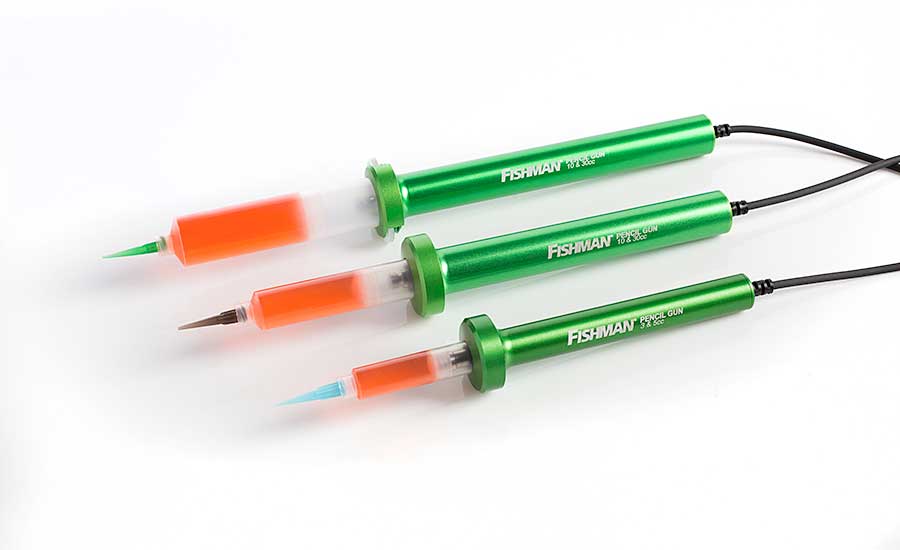Robotic dispensing equipment is an ideal way to increase productivity, enhance quality and prevent rejects. However, these capabilities come at a cost that can’t always be justified. For low-volume production, and applications that don’t have critical dispensing specifications, handheld, powered dispensers provide the answer to many assemblers’ needs.
Some assembly applications simply demand manual dispensing equipment. That’s especially true for companies that make products such as airplanes, boats, furniture, medical devices, musical instruments, recreational vehicles, signs, speakers, tractors and truck trailers.
Handheld tools are ideal for dispensing adhesives, fluids and pastes on delicate parts that require a high degree of touch. Assemblers working in tight or confined spaces also rely on manual dispensing equipment.
Handheld dispensers are available in both palm and pistol-grip configurations. They range from basic, manual units that rely totally on the operator to control dispensing, to more sophisticated units that allow the user to program dispensing time and pressure settings.
Dispensing pens are suitable for manually dispensing continuous beads or applying dots of low-viscosity fluids, such as cyanoacrylates, in noncritical applications.
Air-powered dispensers are popular for most handheld applications, because operators can accurately control the amount of adhesive applied within a reasonable tolerance. Positive displacement dispensers are primarily used for fluids that can change viscosity over time, such as two-part epoxies.
Mistakes to Avoid
“Operators don’t always utilize all of the functions of a handheld dispenser,” says Tom Muccino, sales manager at Nordson EFD. “I’ve been in many different facilities where I walk along an assembly line and see all of the operators using dispensers set in the ‘manual’ mode vs. the ‘time’ mode.
“With the latter, you can set parameters such as pressure and dispense time,” explains Muccino. “With the former, the operator controls how much material they apply. Assemblers keep their foot on the pedal until they think they’ve dispensed enough fluid or paste. Essentially, it’s a glorified manual process similar to using a hand syringe, a squeeze bottle or a toothpick.
“When I inquire about this type of situation, the answer I usually get from supervisors is ‘our operators like to have control over how much they apply,’” notes Muccino. “However, if they don’t utilize all of the features that a dispenser has to offer, that’s actually counterintuitive. It defeats the reason why most manufacturers purchase a dispenser—to provide the precision and control necessary for an assembly application.
“The manual mode can lead to waste and excessive fluid application,” warns Muccino. “The more excess you apply, the longer it takes a joint to harden and cure, which can affect process time and throughput. It can also lead to quality issues due to rejected parts.”
According to Muccino, waste is one of the biggest challenges typically associated with manual dispensing. A common mistake operators make is applying excess material to each part.
More waste typically occurs with two-part adhesives, such as epoxies. Waste also occurs more frequently when bonding small parts that require less adhesive. Often, excessive waste can be avoided through operator training or by investing in automation.
Sometimes, assemblers simply use the wrong type of components for their application. For instance, choosing the correct tip can make a big difference.
“Using the right components can alleviate a lot of down time, due to issues such as clogged tips,” says Muccino. “Tips are one of the most important parts of a handheld dispensing system.
“To maximize the benefits of the equipment, you need to use the correct type of tip,” Muccino points out. “A tapered tip is better for thicker fluids, such as epoxies or soldering paste. On the other hand, a Teflon-lined tip is better for dispensing cyanoacrylates.”
“The type of valve used can also make a big difference,” adds Can La, product manager at Techcon Systems. “Using the wrong type of valve can result in accuracy and repeatability issues.
“Low-viscosity materials, such as cyanoacrylates or UV adhesives, work better with needle- or diaphragm-type valves,” explains La. “High viscosity materials, such as grease, silicones or solder paste, need a spool valve that can suck back excessive material from the needle.”
Another common mistake with handheld dispensing occurs when filling syringes. Traditional filling techniques often cause problems.
During the syringe filling process, most operators will fill through the large end of the syringe and then insert the piston. That forces them to vent the air trapped between the piston and fluid.
According to Omar Regalado, director of global sales at Fishman Corp., the problem with this approach is that assemblers either introduce a small bubble of air into the syringe or they go too far pushing fluid past the piston seal, which eventually allows fluid to leak past the piston.
An air pocket that passes through the dispense tip can “spit” and result in an incomplete dispense, which will result in a rejected part. Air pockets will cause a spring-like compression in the fluid forcing an extended stroke length that increases cycle time.
An alternative approach to syringe filling is to purchase syringes with the piston preplunged to the bottom of the syringe and filled through the Luer lock or the small end of the syringe. This way, a 90-degree Luer to Luer adapter can be attached to the syringe filling system.


















